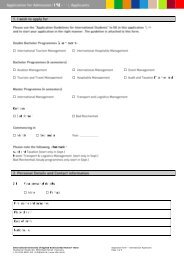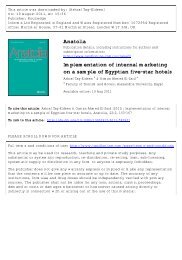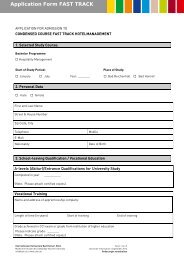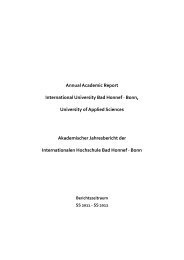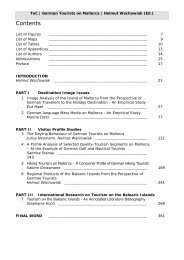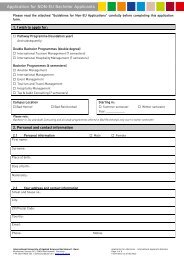The impact of performance measurement in a service factory - IUBH
The impact of performance measurement in a service factory - IUBH
The impact of performance measurement in a service factory - IUBH
Create successful ePaper yourself
Turn your PDF publications into a flip-book with our unique Google optimized e-Paper software.
<strong>The</strong> <strong>impact</strong> <strong>of</strong> <strong>performance</strong> <strong>measurement</strong><br />
<strong>in</strong> a <strong>service</strong> <strong>factory</strong><br />
How <strong>performance</strong> <strong>measurement</strong> <strong>impact</strong>ed employee behaviour and <strong>performance</strong><br />
<strong>of</strong> the housekeep<strong>in</strong>g operations <strong>of</strong> a British luxury hotel<br />
Work<strong>in</strong>g paper<br />
Joachim Sandt, Christoph H<strong>of</strong>fmann<br />
International University <strong>of</strong> Applied Sciences Bad Honnef· Bonn, Germany<br />
Park Plaza Westm<strong>in</strong>ster Bridge, London, UK<br />
j.sandt@iubh.de<br />
mail@chrh<strong>of</strong>fmann.de<br />
<strong>The</strong> paper was accepted and presented by the 8th conference <strong>of</strong>t he PMA – Performance Management<br />
Association at the University <strong>of</strong> Cambridge, 11th July 2012.<br />
Page 1 <strong>of</strong> 11
<strong>The</strong> <strong>impact</strong> <strong>of</strong> <strong>performance</strong> <strong>measurement</strong><br />
<strong>in</strong> a <strong>service</strong> <strong>factory</strong><br />
How <strong>performance</strong> <strong>measurement</strong> <strong>impact</strong>ed employee behaviour and <strong>performance</strong><br />
<strong>of</strong> the housekeep<strong>in</strong>g operations <strong>of</strong> a British luxury hotel<br />
Abstract<br />
In hotel operations, especially housekeep<strong>in</strong>g, f<strong>in</strong>ancial and non-f<strong>in</strong>ancial <strong>performance</strong><br />
<strong>measurement</strong> and management to <strong>impact</strong> employee behaviour to implement the<br />
organization’s goals is <strong>of</strong>ten not systematically and formally applied. <strong>The</strong> case <strong>of</strong> the Park<br />
Plaza Westm<strong>in</strong>ster Bridge hotel is used to show how the implementation <strong>of</strong> <strong>performance</strong><br />
<strong>measurement</strong> and management systems <strong>impact</strong>ed the behaviour <strong>of</strong> the employees. With more<br />
than 1,000 rooms and a high occupancy rate, housekeep<strong>in</strong>g operations are repetitive and high<br />
volume processes. <strong>The</strong>y could be viewed to be a <strong>service</strong> <strong>factory</strong>. <strong>The</strong> management control<br />
framework by K.A. Merchant and Wim Van der Stede will be used to describe <strong>performance</strong><br />
<strong>measurement</strong> and management control systems before and after the implementation.<br />
Formerly, housekeep<strong>in</strong>g operations <strong>in</strong> the case hotel relied primarily on <strong>in</strong>formal action<br />
control and personnel control. <strong>The</strong>n, formal non-f<strong>in</strong>ancial results control and formal action<br />
controls had been implemented. <strong>The</strong> new management control package resulted <strong>in</strong> significant<br />
changes <strong>in</strong> employee behaviour and – thus – <strong>in</strong> the <strong>performance</strong> <strong>of</strong> department.<br />
Keywords: Behavioural <strong>impact</strong>, hotel operations, housekeep<strong>in</strong>g, management controls<br />
systems as a package, <strong>performance</strong> <strong>measurement</strong>.<br />
Page 2 <strong>of</strong> 11
Motivation<br />
In the hotel <strong>in</strong>dustry customer and <strong>service</strong> orientation is paramount. <strong>The</strong>refore, measur<strong>in</strong>g<br />
<strong>performance</strong> contributes to generate transparency and supports direct<strong>in</strong>g employee behaviour<br />
to implement the hotel’s objectives. Hereby, especially non-f<strong>in</strong>ancial <strong>performance</strong> measures<br />
broken down to operational processes and l<strong>in</strong>ked to the f<strong>in</strong>ancial ones are important for<br />
manag<strong>in</strong>g (departmental) <strong>performance</strong>. However, the hotel <strong>in</strong>dustry still seems to have<br />
potential for improvement with regard to <strong>performance</strong> <strong>measurement</strong> and management (see for<br />
the UK hotel <strong>in</strong>dustry for <strong>in</strong>stance Atk<strong>in</strong>son and Brander Brown 2001, 130, “... that UK<br />
hotels companies still seem to be measur<strong>in</strong>g the wrong th<strong>in</strong>gs. In particular, it has been<br />
suggested, that, <strong>in</strong> the ma<strong>in</strong>, the UK hotel <strong>in</strong>dustry appears to concentrate on f<strong>in</strong>ancial<br />
measures.”, see also Harris & Mongiello, 2001, 127, Evans, 2005, 376).<br />
<strong>The</strong> hotel Park Plaza Westm<strong>in</strong>ster Bridge is a four-star deluxe luxury hotel opened <strong>in</strong> the<br />
beg<strong>in</strong>n<strong>in</strong>g <strong>of</strong> 2010. With more than 1,000 bedrooms it is one <strong>of</strong> the largest hotels <strong>in</strong> London,<br />
the UK and Europe. With high occupancy and average rates the first years <strong>of</strong> operation have<br />
been highly successful. However, for the operations high occupancy constitutes high<br />
demands for operational excellence, especially for housekeep<strong>in</strong>g that has to clean hundreds <strong>of</strong><br />
rooms daily.<br />
<strong>The</strong> case <strong>of</strong> the housekeep<strong>in</strong>g operations <strong>of</strong> the Park Plaza Westm<strong>in</strong>ster Bridge hotel will be<br />
analyzed by us<strong>in</strong>g the framework <strong>of</strong> Merchant and Van der Stede (2012). <strong>The</strong> framework<br />
enables to describe the configuration <strong>of</strong> <strong>performance</strong> <strong>measurement</strong> and management control<br />
<strong>in</strong> different situations and/or organizations; the controls can be used more formally or<br />
<strong>in</strong>formally.<br />
Performance <strong>measurement</strong>, management control and management<br />
control systems as a package<br />
Performance <strong>measurement</strong> and management control<br />
Def<strong>in</strong><strong>in</strong>g <strong>performance</strong> <strong>measurement</strong> and management control systems basically refers to<br />
implement<strong>in</strong>g organizational goals (e.g., “the formal, <strong>in</strong>formation-based rout<strong>in</strong>es and<br />
procedures managers use to ma<strong>in</strong>ta<strong>in</strong> or alter patterns <strong>in</strong> organizational activities”, Simons,<br />
1995, 5, “Management control <strong>in</strong>volves managers tak<strong>in</strong>g steps to help ensure that the<br />
employees do what is best for the organization”, Merchant & Van der Stede 2012, 9).<br />
Whereas <strong>performance</strong> <strong>measurement</strong> more strictly refers to quantitative <strong>in</strong>formation used to<br />
support the organizational goals, management controls are more comprehensive. For<br />
example, they <strong>in</strong>clude also procedures to describe how employees have to act. In this paper,<br />
the more comprehensive management control approach will be used to describe and expla<strong>in</strong> a<br />
specific bus<strong>in</strong>ess situation.<br />
Page 3 <strong>of</strong> 11
Management control systems as a package<br />
Management controls do not operate <strong>in</strong> isolation. <strong>The</strong>refore, they have to be considered as a<br />
package (see for example Malmi & Brown, 2008). <strong>The</strong>y might be <strong>in</strong>tentionally designed and<br />
coord<strong>in</strong>ated. In this case one could call it a management control system. It is also possible<br />
that the management controls are not <strong>in</strong>tentionally coord<strong>in</strong>ated, for example due to the design<br />
and implementation by different organisational units, and should not be regarded as one<br />
system but rather as a package <strong>of</strong> systems. Consequently, it is important to understand how<br />
controls can be comb<strong>in</strong>ed, to suit the particular circumstances <strong>of</strong> the organization.<br />
<strong>The</strong> framework by Merchant and Van der Stede<br />
For study<strong>in</strong>g management control systems as a package many alternative conceptual<br />
frameworks are availabe. For example, there are frameworks by Ouchi (1980), Merchant &<br />
van der Stede (2012), or Malmi & Brown (2008). In this paper, the categorization <strong>of</strong><br />
Merchant & Van der Stede will be used as it is not complex, yet comprehensive.<br />
Merchant & Van der Stede (2012) differentiate the follow<strong>in</strong>g management controls to direct<br />
emloyees’ behavior accord<strong>in</strong>g to the object <strong>of</strong> control: results, action, personnel and cultural<br />
controls:<br />
Results controls are an <strong>in</strong>direct form <strong>of</strong> control because they do not focus explicitly on the<br />
employees’ actions or decisions. Results control <strong>of</strong>ten encompass f<strong>in</strong>ancial or non-f<strong>in</strong>ancial<br />
<strong>performance</strong> measures, e.g. pr<strong>of</strong>it.<br />
Action controls focus on actions taken by employees. <strong>The</strong>y are the most direct form <strong>of</strong><br />
management control as they ensure the desired behavior by describ<strong>in</strong>g how employees have<br />
to do certa<strong>in</strong> actions. Standard opert<strong>in</strong>g procedures are an example for action controls.<br />
Personnel and cultural controls focus on the types <strong>of</strong> people employed and their shared<br />
norms and values. <strong>The</strong>refore, they will be grouped <strong>in</strong> this paper under people control. People<br />
controls focus on self- and mutual monitor<strong>in</strong>g , e.g., by personnel selection and placement,<br />
codes <strong>of</strong> conduct, tone at the top.<br />
In addition, management controls can be used either formally or <strong>in</strong>formally (see for example<br />
Fisher 1995). A formal results control could be the operat<strong>in</strong>g pr<strong>of</strong>it <strong>of</strong> a unit. A formal action<br />
control would be a documented standard operat<strong>in</strong>g procedure (SOP). If the SOP is not<br />
documented and desired actions are directly enforced by a supervsior, it would be an <strong>in</strong>formal<br />
action control.<br />
Figure 1: Management Control Package – general categorisation<br />
Comb<strong>in</strong><strong>in</strong>g Merchant & van der Stede’s framework and the differentiation formal and<br />
<strong>in</strong>formal controls, the categorisation shown <strong>in</strong> Figure 1 can be used to describe and expla<strong>in</strong> a<br />
management control package used <strong>in</strong> a given situation.<br />
Page 4 <strong>of</strong> 11
Housekeep<strong>in</strong>g operations <strong>of</strong> a British luxury hotel<br />
<strong>The</strong> hotel: Park Plaza Westm<strong>in</strong>ster Bridge London<br />
<strong>The</strong> hotel Park Plaza Westm<strong>in</strong>ster Bridge, a four star deluxe hotel <strong>in</strong> the heart <strong>of</strong> London, is<br />
owned by PPHE Hotel Group Limited which “owns, leases, develops, manages and<br />
franchises primarily full <strong>service</strong> four-star, four-star deluxe and contemporary lifestyle hotels<br />
<strong>in</strong> major gateway cities and regional centres primarily <strong>in</strong> Europe”<br />
(http://www.parkplazahotels.net/default.asp?section=1166).<br />
<strong>The</strong> Park Plaza Westm<strong>in</strong>ster Bridge hotel is the biggest hotel <strong>in</strong> the PPHE Hotel Group and<br />
one <strong>of</strong> the biggest hotels <strong>in</strong> Europe. <strong>The</strong> hotel was opened early 2010 with 1,019 bed rooms<br />
<strong>in</strong> total, separated <strong>in</strong> several room categories, e.g., Superior, Studio or Suite and 31 state-<strong>of</strong>the-art<br />
meet<strong>in</strong>g rooms. S<strong>in</strong>ce the open<strong>in</strong>g the hotel operates very successfully with high<br />
occupancy and average rates and contributes significantly to the success <strong>of</strong> PPHE Hotel<br />
Group Limited (refer to annual reports PPHE Group, 2012).<br />
Housekeep<strong>in</strong>g operations <strong>in</strong> the hotel<br />
In hotels “(…) the housekeep<strong>in</strong>g department personnel will be responsible for clean<strong>in</strong>g the<br />
rooms and associated public facilities areas, the <strong>of</strong>fices, the recreation facilities, and all public<br />
restrooms” (Jones, 2007, 32) this is true for the Park Plaza Westm<strong>in</strong>ster Bridge hotel.<br />
Furthermore, the housekeep<strong>in</strong>g department <strong>in</strong> the case hotel operates an <strong>in</strong>-house towel<br />
laundry, as well as a uniform room and valet, which is responsible for wash<strong>in</strong>g uniforms and<br />
guest laundry <strong>in</strong>-house.<br />
<strong>The</strong> daily activities <strong>of</strong> clean<strong>in</strong>g hundreds <strong>of</strong> rooms, dozens <strong>of</strong> meet<strong>in</strong>g rooms and <strong>of</strong>fices as<br />
well as all the public washroom facilities is a highly repetitive task; arguably like a assembly<br />
l<strong>in</strong>e type process. <strong>The</strong> housekeep<strong>in</strong>g management team has to balance productivity and<br />
quality to ensure that the department operates efficient and effectively and to the satisfaction<br />
<strong>of</strong> the guests, while ensur<strong>in</strong>g employee satisfaction and motivation <strong>of</strong> the biggest department<br />
<strong>in</strong> a hotel at the same time. Schmenner (1986, cited <strong>in</strong> Verma, 2000) developed a <strong>service</strong><br />
process matrix which <strong>in</strong>cluded the def<strong>in</strong>ition <strong>of</strong> a “<strong>service</strong> <strong>factory</strong>”:<br />
“Services with both low customer contact/customization and a low degree <strong>of</strong> labour<br />
<strong>in</strong>tensity are classified as <strong>service</strong> factories. Analogous to assembly l<strong>in</strong>e type processes<br />
<strong>in</strong> manufactur<strong>in</strong>g, the facilities and equipment account for a large fraction <strong>of</strong> costs.<br />
Much <strong>of</strong> the transportation <strong>in</strong>dustry (airl<strong>in</strong>es, truck<strong>in</strong>g companies), hotels and fastfood<br />
establishments can be classified as Service Factories.”<br />
Consider<strong>in</strong>g housekeep<strong>in</strong>g as a <strong>service</strong> <strong>factory</strong>, productivity <strong>of</strong> e.g. room attendants is def<strong>in</strong>ed<br />
by number <strong>of</strong> rooms cleaned per person <strong>in</strong> a def<strong>in</strong>ed period <strong>of</strong> time, Jones and Siag argue that<br />
“understand<strong>in</strong>g this key activity with<strong>in</strong> the hotel and manag<strong>in</strong>g it efficiently is extremely<br />
important” (2009, 277). Quality is important as well and needs to be measured to ensure that<br />
hotel and cleanl<strong>in</strong>ess standards as well as the customer expectation are met or exceeded. It<br />
becomes clear that the housekeep<strong>in</strong>g operations have a f<strong>in</strong>ancial <strong>impact</strong> (productivity, cost<br />
Page 5 <strong>of</strong> 11
per room cleaned etc.), but also a non-f<strong>in</strong>ancial <strong>impact</strong>s like guest experience and employee<br />
satisfaction. This is understood at the Park Plaza Westm<strong>in</strong>ster Bridge hotel and lead to<br />
implementation <strong>of</strong> <strong>performance</strong> <strong>measurement</strong> and management tools <strong>in</strong> the housekeep<strong>in</strong>g<br />
department.<br />
Performance <strong>measurement</strong> <strong>in</strong> the housekeep<strong>in</strong>g operations <strong>of</strong> a<br />
British luxury hotel<br />
Status quo ante<br />
Dur<strong>in</strong>g the open<strong>in</strong>g phase early 2010 the housekeep<strong>in</strong>g management focused on snagg<strong>in</strong>g<br />
rooms after the builders, first clean<strong>in</strong>g and sett<strong>in</strong>g up rooms, as well as recruit<strong>in</strong>g the <strong>in</strong>itial<br />
team. Right after the open<strong>in</strong>g <strong>of</strong> the Park Plaza Westm<strong>in</strong>ster Bridge hotel, housekeep<strong>in</strong>g<br />
operations were traditionally organized: accord<strong>in</strong>g to the framework <strong>of</strong> Merchant & Van der<br />
Stede, it was ma<strong>in</strong>ly <strong>in</strong>formal action and personnel control with few <strong>performance</strong> measures<br />
(results control).<br />
<strong>The</strong> ma<strong>in</strong> focus <strong>of</strong> the housekeep<strong>in</strong>g team was to turn the dirty rooms <strong>in</strong>to clean and<br />
<strong>in</strong>spected rooms on a daily basis. Room attendants were asked to clean a set amount <strong>of</strong> rooms<br />
dur<strong>in</strong>g their shift, no matter how big the rooms were or how complex the set up was.<br />
Due to the size <strong>of</strong> the new operations and the high volume, the housekeep<strong>in</strong>g management<br />
team was satisfied when (enough) team members showed up to complete the daily workload.<br />
<strong>The</strong> quality <strong>of</strong> work <strong>of</strong> the team members was only controlled through constant presence <strong>of</strong><br />
the housekeep<strong>in</strong>g management team. Shortfalls were dealt with on the spot by address<strong>in</strong>g the<br />
issues with the <strong>in</strong>dividuals directly. No track <strong>of</strong> (<strong>in</strong>dividual) <strong>performance</strong> was kept; all<br />
previous <strong>in</strong>cidences were “<strong>in</strong> the head” <strong>of</strong> the housekeep<strong>in</strong>g management team and not<br />
compiled <strong>in</strong> a formalised way.<br />
Only <strong>in</strong>dividual guest feedback was discussed with the <strong>in</strong>dividual team members as <strong>in</strong>dicated<br />
above. <strong>The</strong> overall satisfaction <strong>of</strong> guests with regards to the cleanl<strong>in</strong>ess <strong>of</strong> the hotel and/or<br />
rooms was not analysed and communicated by the housekeep<strong>in</strong>g management team.<br />
In summary the housekeep<strong>in</strong>g department was focused on turn<strong>in</strong>g the rooms around on a<br />
daily basis, deal<strong>in</strong>g with (the same) problems on the spot and by ensur<strong>in</strong>g quality shortfalls<br />
and guest compla<strong>in</strong>ts are followed up right away with the <strong>in</strong>dividual team member<br />
responsible (see Figure 2).<br />
Page 6 <strong>of</strong> 11
Figure 2 Management Control Package - Status quo ante<br />
Performance <strong>measurement</strong> and management control <strong>in</strong>itiatives<br />
<strong>The</strong> newly appo<strong>in</strong>ted Head Housekeeper <strong>in</strong>troduced formal standard operat<strong>in</strong>g procedures<br />
and non-f<strong>in</strong>ancial <strong>performance</strong> measures:<br />
Figure 3: Attendance Track<strong>in</strong>g<br />
Figure 3 Attendance Track<strong>in</strong>g<br />
Figure 3).<br />
First, to get more transparency and a better basis for workload<br />
assignments a credit system for different room categories was<br />
<strong>in</strong>troduced, a function that is supported by the Property<br />
Management System (PMS) Opera. Due to the size and the setup<br />
<strong>of</strong> rooms, some rooms take longer to clean than others.<br />
Different room categories got different credits to ensure that a<br />
Room Attendant has sufficient time when clean<strong>in</strong>g a room.<br />
<strong>The</strong> credit system is used to automatically assign workload to<br />
the room attendants each morn<strong>in</strong>g and to distribute the work<br />
fairly. <strong>The</strong> credit system forms the basis for accurate bill<strong>in</strong>g<br />
(important as the room clean<strong>in</strong>g activity is outsourced), but<br />
also ensures that productivity can be calculated and monitored.<br />
Second, lateness, absenteeism and sickness are recorded per<br />
position reflect<strong>in</strong>g the employment type. <strong>The</strong> monthly report<br />
(see Figure 3) shows the total amount <strong>of</strong> shifts planned as well<br />
as the number <strong>of</strong> shifts started on time; the percentage <strong>of</strong> shift<br />
started late or had to be covered due to sickness or absenteeism<br />
is shown as well. <strong>The</strong> report has a breakdown per different<br />
employment types (Hotel Staff, Agency 1, Agency 2) and a<br />
break down for lateness (<strong>in</strong>clud<strong>in</strong>g the total number <strong>of</strong> m<strong>in</strong>utes<br />
lost), absenteeism and sickness (per employment type). <strong>The</strong><br />
figure, percentage <strong>of</strong> shifts that were not started on time or had<br />
to be covered, is tracked over the year to identify trends (see<br />
Third, to ensure quality <strong>of</strong> housekeep<strong>in</strong>g operations a spot checklist per room category was<br />
developed. Supervisors use the spot checklist for check<strong>in</strong>g their room attendants’<br />
<strong>performance</strong>. A so-called league table is reported monthly show<strong>in</strong>g all room attendants and<br />
Page 7 <strong>of</strong> 11
their scores from the spot checklist. It is subdivided <strong>in</strong> three sections: > 90% (green) - Well<br />
done!, between 85% and 90% (orange) - Good job, however there is room for improvement!,<br />
below 85% (red) - Oops, what happened this month? You need to work on achiev<strong>in</strong>g<br />
standards. We will help you with it!. In addition, the top three room attendants are rewarded<br />
with vouchers and can apply for the next position (self-check<strong>in</strong>g Key Maid) if they perform<br />
above 90% <strong>in</strong> three consecutive months. A retra<strong>in</strong><strong>in</strong>g programme is <strong>in</strong> place to support low<br />
performers.<br />
Furthermore, the hotel uses an onl<strong>in</strong>e standardized customer feedback form that is distributed<br />
via email to all guests after their stay. Housekeep<strong>in</strong>g related scores and customer feedback<br />
are now reported <strong>in</strong> regular team meet<strong>in</strong>gs to show the direct <strong>impact</strong> <strong>of</strong> their work on the<br />
guest experience. Changes <strong>in</strong> scores for key areas, e.g. (bath)room cleanl<strong>in</strong>ess are tracked<br />
over time (See Figure 4), discussed, and form the basis for corrective action.<br />
Figure 4: Example Customer Feedback Track<strong>in</strong>g<br />
F<strong>in</strong>ally, all <strong>of</strong> the <strong>in</strong>itiatives described above are <strong>in</strong>tegrated <strong>in</strong> the Housekeep<strong>in</strong>g Key<br />
Performance Indicator (KPI) system, creat<strong>in</strong>g a monthly <strong>performance</strong> report that is reviewed<br />
<strong>in</strong> detail and builds the basis for any decisions, focus areas, and changes <strong>in</strong> the housekeep<strong>in</strong>g<br />
department – this <strong>in</strong>cludes the housekeep<strong>in</strong>g management team <strong>of</strong> the hotel, but also the<br />
contracted <strong>service</strong> partner (ma<strong>in</strong>ly for room clean<strong>in</strong>g) that are vital for the housekeep<strong>in</strong>g<br />
operations at Park Plaza Westm<strong>in</strong>ster Bridge.<br />
Figure 5: Management controls <strong>in</strong> use –<br />
status quo ante and additional management controls<br />
Page 8 <strong>of</strong> 11
In conclusion, the additional management controls are formal action controls and nonf<strong>in</strong>ancial<br />
results controls (see Figure 5).<br />
Behavioural <strong>impact</strong> <strong>of</strong> <strong>performance</strong> <strong>measurement</strong> <strong>in</strong>itiatives<br />
After the changes the <strong>performance</strong> <strong>measurement</strong> and management system for housekeep<strong>in</strong>g<br />
was much more formal for the action controls and more <strong>performance</strong> measures were used. As<br />
a result, the <strong>performance</strong> <strong>of</strong> the housekeep<strong>in</strong>g has gone up significantly and is more stable,<br />
which enables the housekeep<strong>in</strong>g management to f<strong>in</strong>e-tune the operations and to focus<br />
strategically on <strong>performance</strong> shortfalls. Furthermore, the use <strong>of</strong> formal action and results<br />
controls has started to <strong>impact</strong> the departmental cultural values.<br />
Distribut<strong>in</strong>g the workload <strong>in</strong> a fair way, had a huge <strong>impact</strong> on the team <strong>performance</strong>. Team<br />
members are able to see that each worker has to ‘pull their weight’; there is no favour<br />
towards certa<strong>in</strong> team members, as everybody receives the same amount <strong>of</strong> credits to clean.<br />
Right after the implementation <strong>of</strong> the control mechanism <strong>of</strong> start<strong>in</strong>g times, number <strong>of</strong> shifts<br />
started on time and the amount <strong>of</strong> m<strong>in</strong>utes <strong>of</strong> work<strong>in</strong>g time lost, became the focus <strong>of</strong> attention<br />
<strong>of</strong> the housekeep<strong>in</strong>g management team as well as <strong>of</strong> the hotel management. <strong>The</strong> availability<br />
<strong>of</strong> the data “forced” the housekeep<strong>in</strong>g management to look <strong>in</strong>to the matter and implement<br />
changes to achieve better results. <strong>The</strong> <strong>measurement</strong> tool enabled the management team to<br />
follow up with the <strong>in</strong>dividuals: “Return to work <strong>in</strong>terviews” were re<strong>in</strong>forced. <strong>The</strong>se changes<br />
educated the housekeep<strong>in</strong>g team, and made them understand that it is important to show up<br />
for work on time as otherwise the behaviour <strong>of</strong> one person has an <strong>impact</strong> on the workload <strong>of</strong><br />
others, as the work had to be covered. Furthermore, the management team got tougher and<br />
started to send team members home who showed up late; ultimately this means for the team<br />
member no earn<strong>in</strong>gs for the day, which then leads to a change <strong>of</strong> behaviour <strong>of</strong> the team<br />
member <strong>in</strong> the future.<br />
<strong>The</strong> cleanl<strong>in</strong>ess quality is very important as the output <strong>of</strong> the housekeep<strong>in</strong>g department has a<br />
direct <strong>impact</strong> on the guest experience and this ultimately has an <strong>impact</strong> on the guest’s future<br />
purchas<strong>in</strong>g decision. <strong>The</strong> implementation <strong>of</strong> regular spot checks and the display <strong>of</strong> names and<br />
scores <strong>in</strong> a league table, as well as reward<strong>in</strong>g top performers have a direct <strong>impact</strong> on the<br />
behaviour <strong>of</strong> the team members. <strong>The</strong> league table creates a positive competitive environment<br />
and animates team members to perform better next time and better than their colleagues. At<br />
the same time, the spot check list system gives the supervisor team the opportunity to lift<br />
their work from a personal to a pr<strong>of</strong>essional level; the tool supports their work, as the<br />
standards are clearly <strong>in</strong>dicated and the scor<strong>in</strong>g system gives a true reflection <strong>of</strong> the<br />
<strong>performance</strong> <strong>of</strong> each Room Attendant. <strong>The</strong> same <strong>measurement</strong> system is used by the senior<br />
management team on the supervisors to ensure their standards are met as well. <strong>The</strong><br />
implementation gives the management team the opportunity to track <strong>performance</strong> over a<br />
period <strong>of</strong> time; <strong>in</strong> comb<strong>in</strong>ation with personal feedback sessions the numerical feedback<br />
proves to be very successful. <strong>The</strong>se data are used <strong>in</strong> annual <strong>performance</strong> reviews to create<br />
personal development plans for the team members.<br />
Page 9 <strong>of</strong> 11
Figure 6: Percentage absent / late / sick & M<strong>in</strong>utes lost due to lateness<br />
Regular housekeep<strong>in</strong>g communication meet<strong>in</strong>gs are held, to ensure a cont<strong>in</strong>uous flow <strong>of</strong><br />
<strong>in</strong>formation. <strong>The</strong> scores highlighted above as well as guest feedback (collected via an onl<strong>in</strong>e<br />
guest survey) are communicated and expla<strong>in</strong>ed. <strong>The</strong>se communication sessions help to<br />
educate the team and ensure that each team member understands the direct <strong>impact</strong> on the<br />
guest experience. <strong>The</strong> communication <strong>of</strong> “hard facts” <strong>in</strong>stead <strong>of</strong> subjective observations <strong>of</strong><br />
the management team is much appreciated by the team. Successful <strong>in</strong>itiatives like “spr<strong>in</strong>g<br />
clean<strong>in</strong>g” can be seen <strong>in</strong> the graphs by the team. For 2012 goals were set for each measured<br />
category – this communicates the goal <strong>of</strong> the hotel and it is broken down to the operational<br />
level and gives the team an <strong>in</strong>dication how they are perform<strong>in</strong>g compared to the hotel<br />
management expectation. Instead <strong>of</strong> “just clean<strong>in</strong>g rooms every day” the team can work<br />
towards to hotel’s goal and see how the hotel is perform<strong>in</strong>g.<br />
<strong>The</strong> KPI system for the housekeep<strong>in</strong>g department had a huge <strong>impact</strong> on the way the<br />
housekeep<strong>in</strong>g department is managed, this <strong>in</strong>cludes the way the hotel housekeep<strong>in</strong>g<br />
management team manages itself, but also the management <strong>of</strong> the contracted <strong>service</strong> partner.<br />
<strong>The</strong> KPI report also gives the hotel management useful <strong>in</strong>sights <strong>in</strong>to the work <strong>of</strong> the<br />
housekeep<strong>in</strong>g department; the availability <strong>of</strong> data changed the way how the departmental<br />
mangers are managed by the hotel management.<br />
Conclusion<br />
In conclusion, the case shows the behaviour and <strong>performance</strong> <strong>impact</strong>s <strong>of</strong> two different<br />
management control configurations <strong>in</strong> a <strong>service</strong> <strong>factory</strong>: a configuration characterized by<br />
<strong>in</strong>formal action control and personnel control had been changed to more formal action<br />
controls and more results controls (i.e. <strong>performance</strong> measures) with a significant behaviour<br />
changes and a <strong>performance</strong> <strong>in</strong>crease. In this case, the <strong>in</strong>troduction and formalization <strong>of</strong> nonf<strong>in</strong>ancial<br />
results and action controls has yielded changes <strong>in</strong> employees’ behaviour and<br />
improved non-f<strong>in</strong>ancial results. F<strong>in</strong>ancial results had not been implemented yet. It could be a<br />
further step to show the <strong>impact</strong> <strong>of</strong> employees’ behaviour also <strong>in</strong> the f<strong>in</strong>ancial management<br />
report. However, the most important aspect had been achieved: to ensure that the employees<br />
do what is best for the organization – <strong>in</strong> this case the housekeep<strong>in</strong>g <strong>of</strong> the Park Plaza<br />
Westm<strong>in</strong>ster Bridge hotel.<br />
Page 10 <strong>of</strong> 11
BIBLIOGRAPHY<br />
Atk<strong>in</strong>son. H., & Brander Brown. J. (2001). Reth<strong>in</strong>k<strong>in</strong>g <strong>performance</strong> measures: assess<strong>in</strong>g<br />
progress <strong>in</strong> UK hotels. International Journal <strong>of</strong> Contemporary Hospitality Management. 13<br />
(3), 128-135.<br />
Evans. N. (2005). Assess<strong>in</strong>g the Balanced Scorecard as a management tool for hotels.<br />
International Journal <strong>of</strong> Contemporary Hospitality Management. 17 (5), 376-390.<br />
Fisher, J. G. (1995). Cont<strong>in</strong>gency-based research on management control systems:<br />
categorization by level <strong>of</strong> complexity. Journal <strong>of</strong> Account<strong>in</strong>g Literature , 14, 24-53.<br />
Harris. P.J., & Mongiello. M. (2001). Key <strong>performance</strong> <strong>in</strong>dicators <strong>in</strong> European hotel<br />
properties: General managers’ choices and company pr<strong>of</strong>iles. International Journal <strong>of</strong><br />
Contemporary Hospitality Management. 13 (3), 120-127.<br />
Jones, P., Siag, A., (2009). A re-exam<strong>in</strong>ation <strong>of</strong> the factors that <strong>in</strong>fluence productivity <strong>in</strong><br />
hotels: A study <strong>of</strong> the housekeep<strong>in</strong>g function. Tourism & Hospitality Research 9, 224–234.<br />
Jones, T.J.A., (2007). Pr<strong>of</strong>essional Management <strong>of</strong> Housekeep<strong>in</strong>g Operations, 5th ed. John<br />
Wiley & Sons.<br />
Malmi, T., & Brown, D. A. (2008). Management control systems as a package -<br />
Opportunities, challenges and research directions. Management Account<strong>in</strong>g Research , 19<br />
(4), 287-300.<br />
Merchant. K.A., & Van der Stede. W. (2012). Management Control Systems. Performance<br />
Measurement. Evaluation and Incentives (3 rd ed.). Harlow et al.: F<strong>in</strong>ancial Times Prentice<br />
Hall.<br />
Simons, R. (1995). Levers <strong>of</strong> control. How managers use <strong>in</strong>novative control systems to drive<br />
strategic renewal. Harvard Bus<strong>in</strong>ess School Press.<br />
Ouchi, W. G. (1980). Markets, Bureaucracies, and Clans. Adm<strong>in</strong>istrative Science Quarterly ,<br />
129-141.<br />
Verma, R., (2000). An empirical analysis <strong>of</strong> management challenges <strong>in</strong> <strong>service</strong> factories,<br />
<strong>service</strong> shops, mass <strong>service</strong>s and pr<strong>of</strong>essional <strong>service</strong>s. International Journal <strong>of</strong> Service<br />
Industry Management 11, 8–25.<br />
AUTHOR BIOGRAPHY<br />
Joachim Sandt<br />
Dr. Joachim Sandt is Pr<strong>of</strong>essor for Management Account<strong>in</strong>g and Control at the International<br />
University <strong>of</strong> Applied Sciences Bad Honnef · Bonn, Germany, and consults companies on<br />
issues <strong>of</strong> <strong>performance</strong> <strong>measurement</strong> and management. E-mail: j.sandt@iubh.de.<br />
Christoph H<strong>of</strong>fmann<br />
Christoph H<strong>of</strong>fmann is Head Housekeeper at the Park Plaza Westm<strong>in</strong>ster Bridge hotel <strong>in</strong><br />
London, United K<strong>in</strong>gdom. He founded and manages an onl<strong>in</strong>e forum for housekeep<strong>in</strong>g<br />
pr<strong>of</strong>essionals: hsk-knowledge.com. Formerly he worked on Six Sigma projects for Starwood<br />
Hotels & Resorts. E-mail: mail@chrh<strong>of</strong>fmann.de.<br />
Page 11 <strong>of</strong> 11



